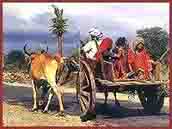Problems faced by Indian Agriculturist
 |
| |
| 1. | Lack of education and awareness about opportunities. |
| |
| 2. | Lack of Market Knowledge and Marketing skills. |
| |
| 3. | Lack of professionalism and small land holding. |
| |
| 4. | Absence of innovative financing for agriculture. |
|  |
| |
| 5. | Agriculture has become un-viable due to over supply because new hybrids are giving excellent yield but due to over supply, the price realization is very low. |
| |
| 6. | Cost of transport to market, electricity for water pump, cost of fertilizers, cost of living is going up several times but the selling price of agriculture produce is stagnating due to over supply and record productions. |
| |
| 7. | Lack of reliable Agriculture publication and media to provide latest and reliable localized data. |
| |
|
|
|
Economic Evolution of Indian Agriculture
Indian agriculture is undergoing a rapid change particularly since mid-sixties i.e. from the on-set of ‘Green Revolution’. Therefore, we have witnessed a ‘white Revolution’ marking a tremendous increase in the milk production. Our horticulture, which includes fruit production, floriculture and vegetable production is also making a tremendous heading and it is said that ‘yellow Revolution’ is in the sight.
If we analyse this changing scene in agriculture, we can notice that the traditional agriculture. Which was a ‘way of life’ for our farmers is now becoming a ‘business proposition’. In the traditional farming there was no much change in the cropping pattern, cultivation practices etc. It was based on the experiences transmitted from father to the son. However, with the developments taking place due to five-year plans and technologies developments in agriculture, traditional farming is changing into modern farming. Traditional farming is slowly becoming absolute and uneconomic. Traditional farming was more or less self-sufficient. No, farming is becoming market oriented. The needs of the farmers are increasing. He has to purchase many things such as high yielding seeds, fertilizers, pesticides, machinery etc. from the market. As a result, his investment and financial needs are increasing. Naturally, he has to produce and get income to meet the costs and also to make some profit. This, the costs, returns, markets, profits of the enterprise become significantly important. This is nothing but ‘Agri-economics’.
With increasing population, rapid urbanization and growing export markets, the demand for farm products is increasing and is likely to increase in the near future. However, the competition is also likely to increase. The consideration of economic aspects in the production process is inevitable.
As indicated above, there has been a technological break-through in agriculture in recent years. New non-traditional crops, new varieties of crops, new methods of cultivation are coming in very fast and farmers are adopting the same. A large number of farm products are being produced for exports. However there are specifications about the size, color, quantity, taste, packaging etc. Which farmers should know. Farmer has to consider all these aspects and consider the costs and returns before entering into the venture.
Farmer has several enterprises (such as crops, dairy, and poultry) on the farm. He has to consider the economics of each enterprise separately also of the farm as a whole. It helps in decision making and proper planning of the farm. Now, the time has come that every activity on the farm has to be viewed from the perspective of economics.
Along with the adoption of new technology in farming, the problems faced by the farmer’s fare also increasing. There are problems of soil and water management, choice of crops, technical know-how, pests and diseases, natural hazards, marketing, finance, surplus production, price fluctuations and so on. In finding the solutions for these problems, economic criteria are to be applied.
India is a vast country with varied climate, soils, and ecological conditions. In addition to this, individual farmer is having his own set up of resources and socio-economic situation. In solving the problems of individual farmers all these situational factors are to be taken into account.
An important ray of hope, which one can notice in this complex changing scenario of agriculture, is that a new generation of farmers who are more educated, young and energetic have taken up to this enterprise. In addition, many non-farming community entrepreneurs are also attracted towards agriculture. They are very keen on getting more knowledge about the new technology. Many of them are innovative and experimenting of their own. Naturally, they are more economics oriented.

